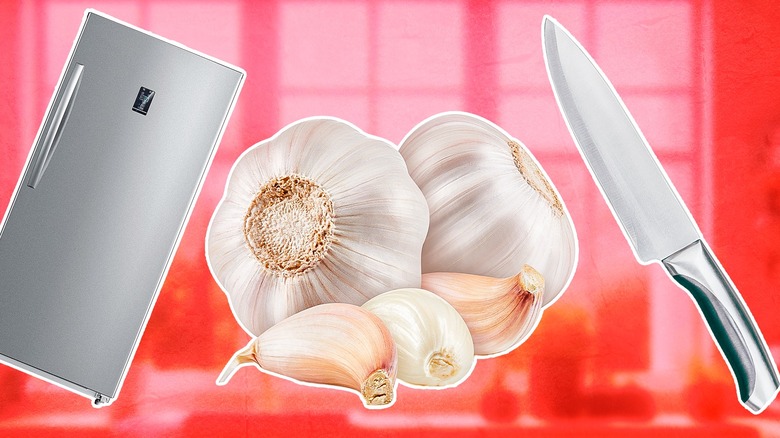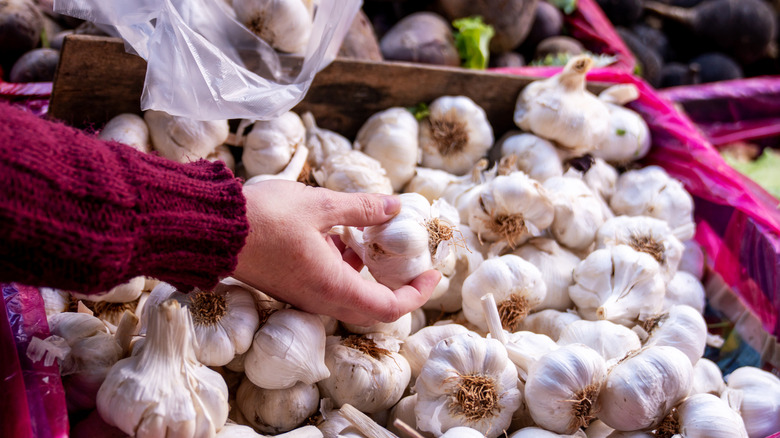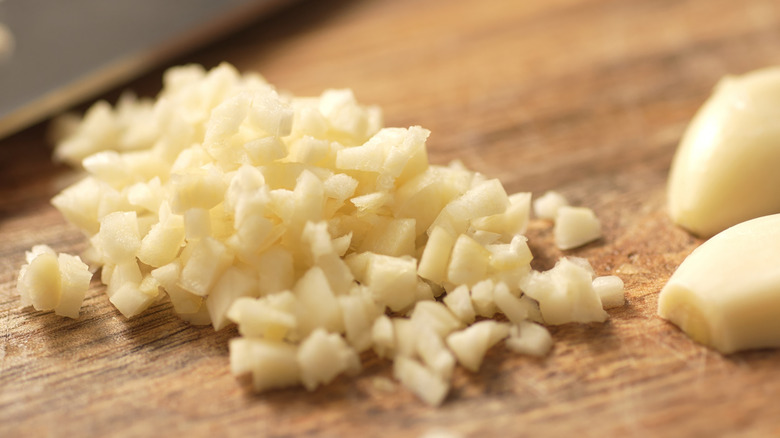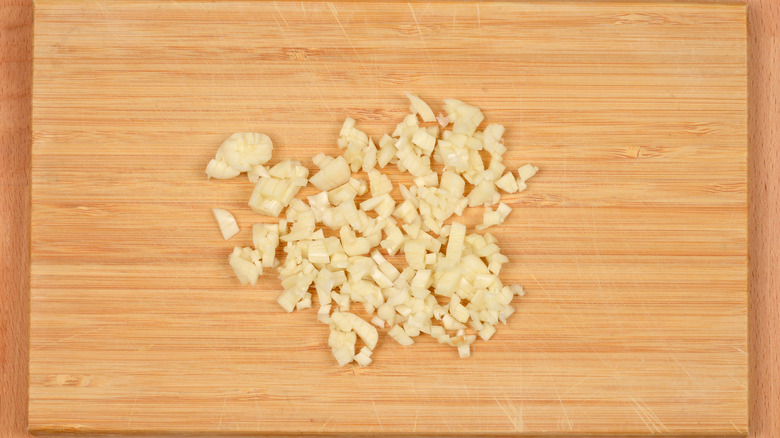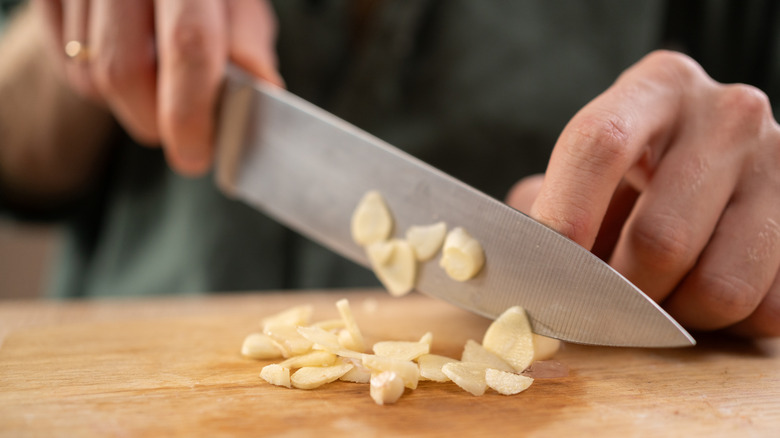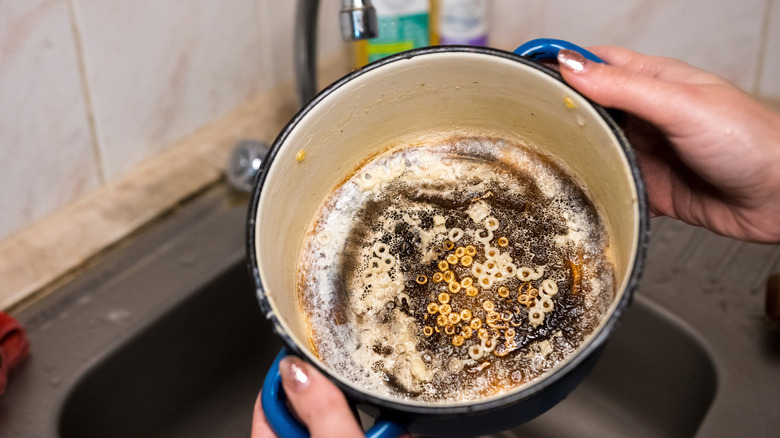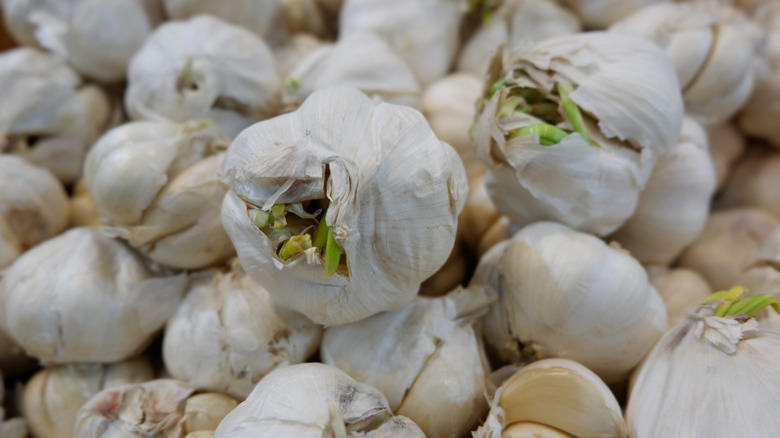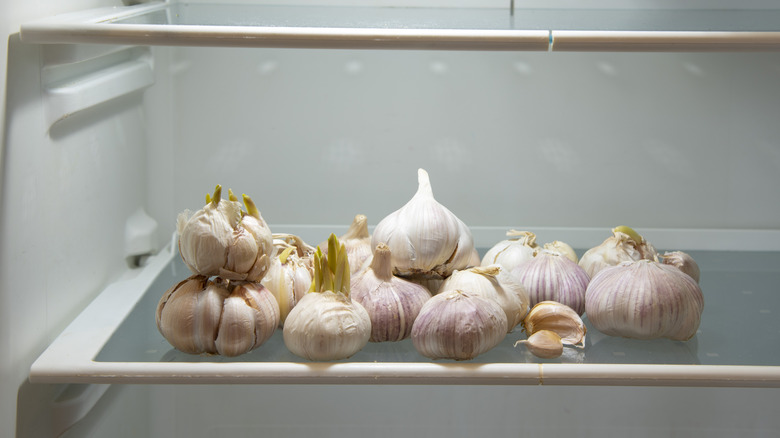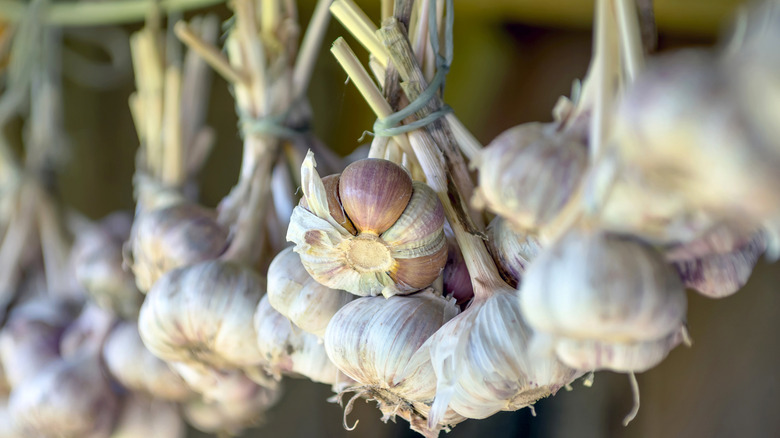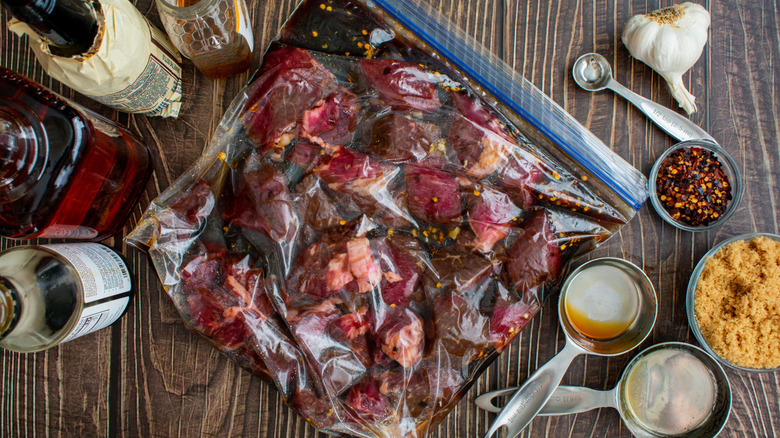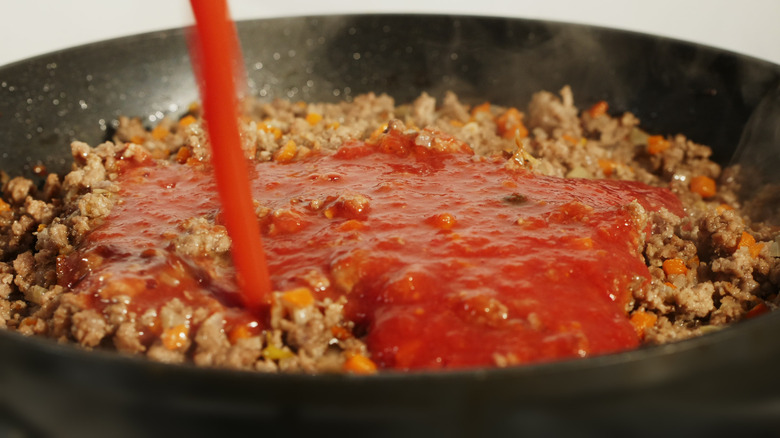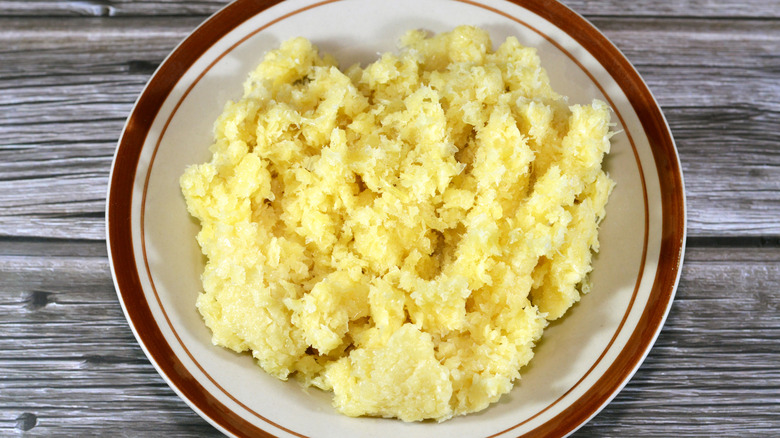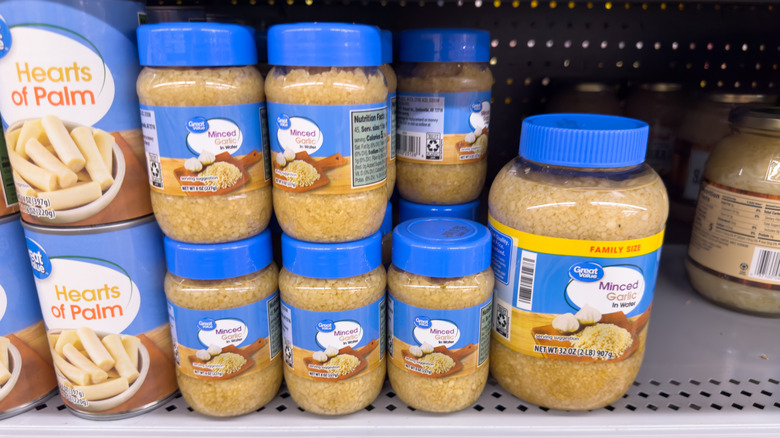14 Common Garlic Mistakes That Are Ruining Your Dishes
We may receive a commission on purchases made from links.
Garlic is as near a universally popular flavoring as you could imagine. There are relatively few of the world's major cuisines where it isn't used, partly because it grows almost anywhere humans choose to live. But primarily, it's because it brings a richly aromatic flavor that complements most savory dishes. Only onions, its cousins in the allium family, really rival it in versatility.
I have a lifelong love affair with garlic as a home cook, an avid gardener, and as a trained chef and former restaurateur. I've harvested my own garlic and garlic scapes fresh from the garden, and also ordered it by the case from wholesalers. In short, I've handled more of it than most people. I've also taught hundreds of cooking classes and answered thousands of questions about cooking, many of them centering around garlic and its uses.
So here are 14 common mistakes people make when cooking with garlic, many of which I've made myself along the way. Believe me when I say that learning from others' mistakes is better than ruining your own meals!
Not choosing the freshest garlic
My top tip with garlic is to treat it like any other kind of produce, and always buy the freshest you can find. Garlic can be planted in autumn for an early-summer harvest, or in spring for mid- to late-summer harvest, so broadly speaking, summertime is when it's at its very best.
Garlic's available year-round because it stores well, but its quality deteriorates as we get deeper into the storage-garlic months. If you don't know what to look for when buying garlic at the grocery store, I'd sum it up in a single word: moisture. A fresh bulb of garlic is very firm and heavy for its size, because it's juicy and not shriveled. The skin should look and feel firm and tight.
As garlic ages, it will begin to dry out. Those bulbs will feel dry and squishy to the touch, and the papery skins will be both looser and more papery. During the late winter and early spring, supermarket garlic is — generally speaking — not great. If you have access to international markets, you'll often find that the garlic there is both better and cheaper.
Always cutting your garlic the same way
A lot of us settle into comfortable routines when cooking. That's not inherently a bad thing: Routine means we can cook on autopilot, while still monitoring the kids or fielding a work-related call. It's a way to stay organized and on track, but there are times when you need to change things up — cooking with garlic is one of them. You may usually reach for a garlic press, or smash the cloves and coarsely chop them, but take a moment to consider how you're going to use the garlic in your dish. You might not know it, but the way you prep your garlic affects its taste.
The rule here is that smaller pieces release more of the garlic's pungent flavor compounds. The less you cut, the milder the flavor. Chopped garlic has a stronger flavor than sliced, minced garlic is stronger than chopped, and crushed to a paste is strongest of all. Choose accordingly, or (when in doubt) follow the recipe's instructions.
Settling for inconsistent texture
People who love to cook often fantasize about going to culinary school. Learning professional techniques and skills (goes the theory) will give you a solid foundation and unleash your own creativity. That's true as far as it goes. But culinary school is hard work, and in the first year, there's a whole lot of drudgery. Spending hours of your life making square cuts from round vegetables doesn't sound like a good time, and frankly, it isn't. But we do it anyway, because food that's cut consistently will also cook consistently, and that's important.
It's especially so with garlic, for a number of reasons. First, as just mentioned, how you cut your garlic controls its pungency. More importantly, having consistently-sized pieces of garlic means they'll cook evenly and yield better finished dishes. You won't have to worry about having both scorched and under-cooked garlic in the same dishes, or a guest unexpectedly getting a large and sinus-clearing mouthful. So yes, it's "a finesse thing," but for practical reasons rather than showing off.
Not oiling your knife
One thing every cook knows about garlic is that its juices are really, really sticky, so it's almost like cutting caramels or gummy bears. It's especially problematic if your garlic isn't absolutely fresh, because as the garlic loses moisture to evaporation, its juices become even more concentrated and sticky.
So that's going to complicate your efforts to make nice, even cuts with your garlic. It helps if your knife blade is sharp, so you're slicing rather than crushing the garlic's cell walls, but even so, your knife blade will get sticky, and garlic will cling to it. Oiling your knife is a simple chef's hack that makes chopping garlic easier.
My mom used to grease her scissors with butter before cutting taffy into pieces, and this trick works on the same principle. Carefully oil your blade with a few drops of oil and a paper towel, or simply spray it with pan spray and wipe away any excess. Now, when you cut, the oil helps keep the garlic from sticking to your blade. Now you'll find it much easier to slice or chop your garlic neatly and evenly.
Putting it in too early is a mistake
One thing experienced cooks routinely do, whether we're (ahem) seasoned home cooks or former professionals, is read any new recipe with a critical eye. Sometimes the ratio of ingredients will be off, or perhaps there's something in the instructions that makes us raise an eyebrow.
One of those, for me, is when the garlic goes into a recipe too early. A surprising number of recipes have you throw it into the pan right away, along with the onions or other aromatic ingredients. That's usually a bad idea, because garlic cooks (and burns) faster than onions. That's partly because it's higher in sugar than onions, partly because it's usually cut smaller, and partly because it contains less water and therefore its sugars are more concentrated. You're better off to add the garlic after the remaining aromatics have softened, and right before you add the main ingredients or a cooking liquid. It only takes a few moments for the garlic to mellow and become fully aromatic.
An exception here is some recipes where garlic is added to the oil early on, and then scooped out. This way it flavors the oil, which in turn bastes the other ingredients in that garlicky goodness, but there's no risk of the garlic itself burning. Often, you'll add it back right at the end of the cooking time, before the dish is served.
Coming in hot
When it's getting late, and you want to get dinner on the table, cranking up the heat under your pan is a real temptation. I get it, really. Been there, done that. But it's very often a mistake, especially when you're cooking with garlic.
Here's the thing: A lot of foods tolerate a bit of overzealous browning with a steak, you can even get away with calling that an extra-hard sear, but you can't do this with garlic because, as mentioned above, it burns quickly. In fact, garlic will burn in a heartbeat if you're working with a pan that's too hot, and that's not good.
Garlic's sugars caramelize nicely at moderate heat, and some recipes take advantage of that. But in a hot pan, you're getting burnt sugars, which are nasty, and even nastier because of garlic's potent sulfur compounds. Burnt garlic is bitter and acrid, and it'll spoil your dish. You'll need to scrape it into the disposal and start over, and then how much time have you saved? Slow it down, cool it down, and spend the extra few minutes. You can thank me later.
Not removing the germ
One thing that's worth remembering about garlic, onions, potatoes, and many other foods is that their real purpose isn't feeding us; it's reproducing and making a new plant, and that means they're prone to sprouting. I'm onside with that, as somebody who grows garlic, but it does have an impact on your garlic's flavor. Have you ever sliced a garlic clove in half and found a green sprout inside? That sprout is the germ of the new plant. If you took one of those sprouting cloves and put it in the soil, it would grow into a whole bulb. Unfortunately, that sprout is less than desirable from a culinary perspective. While it recognizably tastes of garlic, it's a relatively harsh and unpleasant garlic flavor.
Please understand, it's safe to eat garlic with green sprouts in it; they don't contain toxic glycoalkaloids like potato sprouts. If you choose to go ahead and just use it as-is, that's your call. Just know that your food will taste better if you take a moment to remove the sprout first.
Keeping it in your fridge
Garlic is a naturally long-storing ingredient. You've probably seen braids of garlic hanging in a shop or kitchen at one time or another, and it holds up surprisingly well for several months with no further effort. As long as your garlic bulbs are kept whole, then, you don't need to refrigerate them. In fact, the refrigerator can be counter-productive. For one thing, the air inside modern frost-free fridges is pretty dry, so garlic loses moisture quickly. Also, garlic needs to be "stratified" (chilled) before it can grow. Keeping it in the fridge simulates winter and encourages the garlic to sprout. You don't want that.
By all means, refrigerate peeled or separated cloves or garlic you've already minced. But the best way to keep garlic fresh is at room temperature. Any well-ventilated place that's out of direct light (like your pantry) is fine. If it's in a plastic bag, swap it into paper instead because paper won't trap moisture. I like to save onion bags for my garlic harvest and hang them in my basement. For the working garlic in my kitchen, I have a terra cotta garlic keeper that holds a few bulbs at a time and keeps them in excellent condition.
Not laying up a supply while it's at its freshest
I said at the start that my top tip was using the freshest garlic you can find (that's why I grow my own). At the time of writing, I've just harvested my scapes, and in another month or so, my year's supply of garlic will be curing in the shade of my big, breezy porch. You don't have to grow your own, though it's fun to experiment with different types of garlic (I grow a hardneck variety called Music). Instead, while garlic is at its freshest and best, load up at your favorite grocery store or farmer's market. As long as you're not living in a postage stamp-sized apartment, there's little downside to laying in a supply.
Remember, it will keep for months just hanging in a cool place with good ventilation. I do that with about half of my harvest. The rest, like my garlic scapes, I puree with just enough oil to make a smooth paste. Then I pack it into zipper-seal freezer bags and press them flat, squeezing out the excess air. When I want some to cook with, I open a bag, break off a suitably-sized piece, and return the rest to the freezer. Just don't try to preserve whole cloves in oil in your pantry, at room temperature, because that's a serious botulism risk unless it's done just so.
Mincing garlic for marinades
Marinades are a great flavor-booster. They usually contain a liquid ingredient (maybe wine, vinegar, or citrus juice) and an oil as their base, to capture both water-soluble and fat-soluble flavors, and then flavoring ingredients such as herbs, spices, umami bomb favorites like Worcestershire or fish sauce, and (yes) garlic.
I'm not saying garlic doesn't belong in your marinades, because it's a good flavoring. The problem comes when your food leaves its comfy marinade bath and goes out to the grill or a hot skillet. If you've minced or finely chopped the garlic in your marinade, those small pieces will cling to the food when you start cooking it. Then, in the heat of the grill or the skillet, they're likely to burn, and we've already talked about the unpleasant flavor of burnt garlic.
So instead of mincing the garlic in your marinade or crushing it in a garlic press, go big. I usually place whole cloves on my cutting board and then smash them under the flat of my knife blade, to crush (but leave intact) the entire clove. That way, you still get plenty of garlic flavor in the marinade, but the garlic itself stays behind in the mincing bowl instead of moving to the grill. Win-win.
Not using enough garlic
I like garlic, so I use it freely. If a recipe serving four calls for just a single clove of garlic, I'll usually start with two. And my garlic is unusually large, because my father selected for size for many years, and I've kept the same strain going since he passed away (yes, I literally grow "heirloom" garlic).
Garlic's flavor is naturally bold, so it only makes sense to be bold in your usage of it. Live a little! You know now that you can make it milder by how you cut it, and most people know that roasted garlic (whether done in its own garlic baker or inside a chicken) is pretty mellow. So be fearless and dial it up a notch or two, until you have a good feel for your tolerance of garlic and how much everyone else in your household likes it.
Usually, you'll find that it's more garlic than you might have thought. A surprising side effect of this experiment is that, rather than dominating the dish, garlic often helps bring out the best in other ingredients like herbs, fresh tomatoes, or greens (simply sauteeing fresh summer greens with minced garlic is one of my favorite side dishes).
Using too much garlic
I know, I just encouraged you to use more. I'm not being inconsistent in taking the other tack as well (I promise!), I'm just encouraging you to exercise some judgment. For example, there was a time in my life when I'd slice raw garlic into my sandwiches. As much as I love garlic, I don't do that anymore.
There's a line, and you'll need to decide for yourself where to draw it. For me, it's all about context: If the dish's flavors are delicate, use a light hand and prep your garlic so that it's mild (or even leave it out altogether). To give a couple of examples, I'd use garlic lightly if at all on a piece of sole or other delicate white fish, whereas something like rich, fatty mackerel will stand up to garlic. With heavily spiced beef, lots of garlic is fine; with milk-fed veal, I'd be cautious. Similarly, I'll use lots of garlic in a slow-cooked bean dish, but use it sparingly, if at all, with my garden-fresh peas.
One really great example of restraint with garlic is the time-honored French custom of simply rubbing a salad bowl with the cut side of a clove. It leaves just a gentle hint of garlic on the salad, without being at all intrusive.
Discarding it when it gets discolored
I grew up with the ethos that you simply don't waste food, period. That served me well as a chef because food waste is a drag on profit margins. Those who worked for me as prep cooks will remember me lecturing them about my East Coast frugality gene. What has that got to do with garlic? Well, garlic has a weird characteristic that I've been asked about in cooking classes. Have you ever fished the garlic out of a dish or marinade and discarded it in a panic, because it's turned a bizarrely vivid shade of green or blue? It happened to me before I got serious about cooking, and it was disconcerting. I was happy to learn that this is a complete non-issue: It's just a chemical reaction when garlic meets acidic ingredients, like vinegar, lemon juice, or lime juice.
It has absolutely nothing to do with flavor or edibility, so it's still fine to use. In fact, you might even want to showcase its color and use it as a decorative element on your plate. The only time you actually should throw it out is if you've had raw meat, fish, or poultry sitting in the marinade. In that case, it won't be food-safe unless you cook it afterwards.
Being a garlic snob
This one may shock some people who are used to professional chefs teeing off on people who use convenience products. I've made it clear that I'm a big fan of fresh garlic (that's why I grow it, obviously), but please don't let perfect be the enemy of good. Many of the people who've taken my cooking classes are elderly or have physical challenges. Even those of us who are completely healthy often cook within tight time constraints. This is why convenience products exist, and I am a strong advocate of using them when it's appropriate.
Hate peeling garlic? Buy a jar of peeled cloves. Don't have the time or dexterity to mince? Buy it minced in a jar, or as a tube of paste. Even garlic powder has its place; it's great in things like dry rubs and marinades. If it takes a convenience product for you to get good food on the table and indulge your love of garlic and cooking, so be it! Don't let the garlic snobs ruin your love of cooking or shame you for doing what you need to do.
